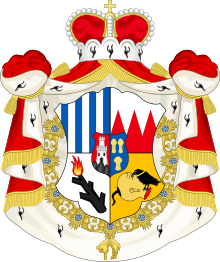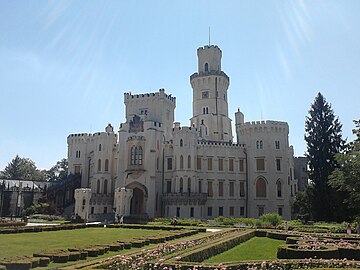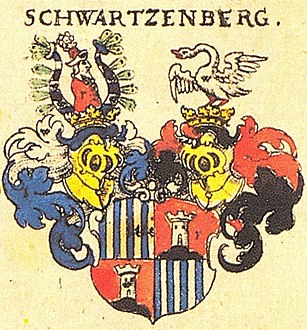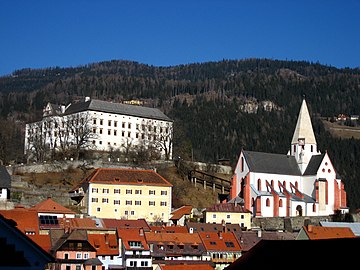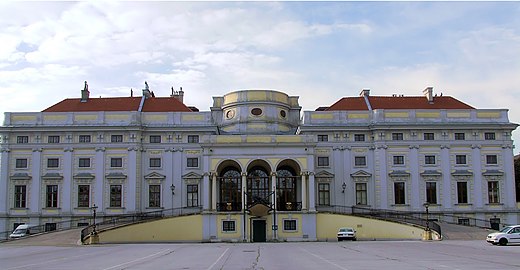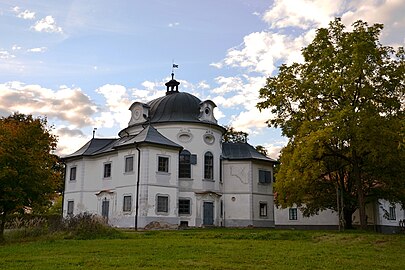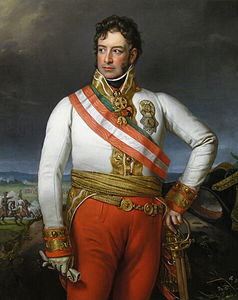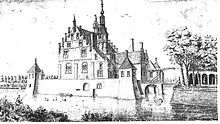Schwarzenberg (Franconian-Bohemian noble family)
| Princely house of Schwarzenberg | |
|---|---|
| title | |
| States | |
| Gentlemen | |
| Headquarters | Schwarzenberg Castle |
| Parent company | Home of being |
| founding | 917: Headquarters 1421: Schwarzenberg acquired |
| founder | Erkinger I. |
| Head of house | Prince Karl zu Schwarzenberg |
| motto | NIL NISI RECTUM Nothing but the right thing |
Schwarzenberg (in Czech language Schwarzenbergové pl (.), Formerly Švarcenberkové ) is the name of one of Seinsheim in francs originating Uradelsgeschlechts , the family of Seinsheim comes from and after 1405 acquired Schwarzenberg Palace in Steigerwald named, which is still owned by the family .
Since the 15th century, the family has been purchasing estates in Bohemia , where they were one of the largest landowners until 1946, and they also inherited lands in Austria and in southern and western Germany. The Franconian-Bohemian House of Schwarzenberg provided many influential statesmen at the imperial court of the Habsburgs in Vienna, rose to imperial counts in 1599 and imperial princes in 1670 and ranks among the nobility . The former royal house is still located in Bohemia and Austria today.
A baronial branch emigrated from Franconia to the Netherlands in the 16th century, where it was accepted into the local nobility and also exists to this day.
Historical overview
The Seinsheimer family saw the Alemanni Prince Erkinger, who was executed in 917, his ancestor and his son Conrad his namesake. In 1243, Stephansberg Castle appeared as the property of Apollonius the Elder. Ä. from Seinsheim. His son Hildebrand († 1386) is considered to be the progenitor of the Schwarzenberg family, since after him and his brother the lineage is divided into an older or Stephansberger line and a younger or Seinsheim line .
Hildebrand's grandson, Erkinger I. von Seinsheim, Freiherr von Schwarzenberg , acquired the Franconian rule of Schwarzenberg with Schwarzenberg Castle in 1405 and Hohenlandsberg Castle in 1435 , both in the Steigerwald. In 1422 King Sigismund pawned the Libenice estate with the mountain village of Grunta . He carried the title of Freiherr zu Schwarzenberg and Hohenlandsberg. At that time the family already owned several farms in Bohemia. In 1550 Wilhelm zu Schwarzenberg came into the possession of the Gimborn rulership in the Bergisches Land through marriage . In 1599 the Schwarzenbergs were elevated to imperial counts with Adolf von Schwarzenberg and in 1670 to imperial princes with Johann Adolf von Schwarzenberg .
Due to the marriage (instead of an adoption) with the much older Anna Neumann von Wasserleonburg, her widower Georg Ludwig Reichsgraf von Schwarzenberg inherited the Obermurau Castle in Styria in 1623 with forest property of around 18,000 hectares , which is still owned by the family; this also includes the castle ruins of Frauenburg .
In the 1670s the Schwarzenbergs settled in Bohemia, and from 1698 they owned Vimperk Castle there . After the counts of Sulz died out , Klettgau , which was raised to a duchy landgraviate in 1698, with the Rottweil hereditary court judge, came to the Schwarzenbergs through the marriage of Maria Anna von Sulz to Ferdinand von Schwarzenberg. Since then, the Schwarzenbergs have also been Counts of Sulz and Landgraves of Klettgau. The administrative seat of the Schwarzenberg rule in Klettgau was Tiengen Castle .
After the death of Johann Christian von Eggenberg in 1710, who had no descendants, his widow Marie Ernestine Countess zu Schwarzenberg inherited the Bohemian dominions Krumau and Nettolitz , she died in 1719. Since the Eggenberg family had expired in the male line at that time, she put her nephew Adam Franz Karl zu Schwarzenberg as a universal heir. In the 18th century, the Schwarzenbergs acquired earlier property from the important Bohemian Counts of Rosenberg (Rožmberk), including the Wittingau ( Třeboň ) castle . From 1719 to 1871 their main seat was the originally Rosenberg, then Eggenberg Castle Krumau (in Český Krumlov ), then Frauenberg Castle ( Hluboká nad Vltavou ) near Budweis ; Furthermore, since 1719 the former Rosenberg castle Orlík nad Vltavou (also called "Worlik") belonged to the family property, which was restituted to the Schwarzenbergs after the Velvet Revolution of 1989 by the Czechoslovak state. In Prague the family owned the Schwarzenberg Palace from 1719 and the one in Vienna ( Schwarzenberg Palace on Schwarzenbergplatz ) from 1716 .
Třeboň Castle , Bohemia
Český Krumlov Castle (Bohemian Krumlov)
Hluboká nad Vltavou Castle , Bohemia
Protivín Castle , Bohemia
Schwarzenberg crypt chapel near Domanín
From 1784 to 1877 the burial place of the Schwarzenberg family was located in the Church of St. Egidius in Třeboň . After the completion of the new burial chapel at the Weltteich near Domanín , it was used as a family crypt until 1938.
The male members of the aristocratic family were mostly soldiers, state officials or church dignitaries, including Prague archbishops, as well as large landowners, entrepreneurs and art collectors. They created ponds and forests on their newly acquired estates and introduced new technologies in agriculture.
From the end of the 18th century, two lines of the Schwarzenberg family were formed, the so-called First Majorat (also called Primogenitur ) with the Imperial Prince Joseph II as the first Majoratherr and the Second Majorat (also known as SECONDOGENITURE ) of his younger brother Karl I. Philipp , who lived in 1804 also received a hereditary prince title. Since Heinrich's Primogenitur line had no male descendants, Heinrich adopted the heir to the Secondogenitur, Karel Schwarzenberg , which reunited the two majorates in 1979.
coat of arms
Blazon : The family coat of arms is “split seven times from silver and blue; on the helmet with blue-silver blankets a bearded man's torso in a red skirt with a silver collar and a crowned, silver-sculpted red pointed hat, which is decorated with three natural peacock feathers, between two in the mouths with three each, and outside with seven natural peacock feathers each, Buffalo horns divided seven times by blue and silver . "
Seinsheim coat of arms from Scheibler's book of arms , 1450
Prince Schwarzenberg Sekundogenitur ( Orlíker line)
archive
The archive of the Scheinfeld rule of the princes of Schwarzenberg is one of the largest regional archives in Middle Franconia . The archive records of around 800 running meters, which were created in the early 14th century and continued until 1899, consist of around 3500 documents, including numerous royal and prince documents, as well as 1500 official books, thousands of accounting volumes and files. In 1944, in order to protect it from damage or destruction by the Allied air raids in the greater Nuremberg area during the Second World War , it was relocated to Krumau in Bohemia, initially planned for a temporary period . After the end of the war and the expropriation of the zu Schwarzenberg family in Czechoslovakia , the repatriation did not take place.
In 1965 the claim to the archive was transferred from the Schwarzenberg family to the Federal Republic of Germany in the course of a settlement regarding reparation payments for property seized in the Third Reich . After decades of efforts to have it returned, the archive was returned in 2011 and handed over to the Nuremberg State Archives .
Today's possessions
The Franconian family residence Schloss Schwarzenberg has always been owned by the family, even if it has not served as a residence for several centuries. The Bohemian possessions of the elder line (First primogeniture), including Trebon Castle (Trebon), Český Krumlov (Český Krumlov) and castle Hluboka nad Vltavou (Frauenberg) in 1940 confiscated by the Nazi regime, as the family patriarch Adolph Schwarzenberg as dissidents into exile had fled. Since the provisions on the expropriation of German property were not applicable to Adolph Schwarzenberg after the end of the war, the Czechoslovak parliament issued the Lex Schwarzenberg in the summer of 1947 . It transferred the family property into state property without compensation. The older Schwarzenberg-Frauenberg line expired in 1979.
Karel Schwarzenberg comes from the second generation line at Orlik Castle and was adopted by the last heir of the older line; since 1979 he has been the head of the Schwarzenberg family. In addition to the Schwarzenberg Castle, he also owned the Austrian possessions Murau Castle , Styria (in the family since 1617) with around 18,000 hectares of forest and the Schwarzenberg Palace in Vienna.
After the Velvet Revolution in 1989, a restitution law was passed in what was then Czechoslovakia. Prince Schwarzenberg then got back considerable parts of his father's former forest property and agricultural land with the Orlík Castle on the Vltava, Čimelice Castle and the Karlov hunting lodge in Smetanova Lhota . However, he refrained from demanding the return of the very extensive possessions of the older Krumau-Frauenberg line, to which he would also have been entitled as an adoptive heir. In the meantime, Karel Schwarzenberg has given the extensive family property to his eldest son.
Schwarzenberg Castle , Middle Franconia
Murau Castle , Styria
Schwarzenberg Palace in Vienna
Orlík nad Vltavou Castle , Bohemia
Čimelice Castle , Bohemia
Karlov Hunting Lodge, Smetanova Lhota
genealogy
House of Seinsheim
- Erkinger († 917)
- Conrad
- ...
- Apollonius d. Ä. († 1311)
- Heinrich (1298- † January 21, 1345) ⚭ Vella kitchen master von Nordenberg
- Hildebrand († 1386)
- Anna (1335 master of the Sulz monastery)
- Christina († 1350) ⚭ Kraft from Lentersheim to Neuen-Muhr
- Michael (I.) († 1399)
- Erkinger (VI.) Also called von Saunsheim (1362–1437) founded the Pons Mariae Astheim monastery with his wife Anna von Bibra in 1409 as a burial place for the family and acquired Schwarzenberg in 1420, was appointed baron in 1429 and in 1435 bought the Hohenlandsberg estate in Franconia .
- Eberhard von Saunsheim (Seinsheim) (* around 1385 at Gnötzheim Castle (?); † December 27, 1443 at Horneck Castle ) was a German Master of the Teutonic Order .
Lords of Seinsheim and barons of Schwarzenberg
- 1429–1437 Erkinger (I.) (As above Erkinger VI.), Had at least six sons
- 1437-1469 Michael (II.); his brother Sigismund (1430–1502) received Hohenlandsberg (see below)
- 1469–1499 Michael the Elder J. (III.), From his (controversial) half-brother Michael von Schwarzenberg zu Hürblach († 1489) comes the line of the barons thoe Schwartzenberg en Hohenlansberg , which is still flourishing in the Netherlands today (see below, Frisian line)
- 1499–1510 Erkinger (II. Or III., Because of an uncle of the same name)
- 1510–1526 Wilhelm (I.)
- 1526–1557 Wilhelm (III.), Acquired the rule of Gimborn through marriage in 1550 .
- 1557–1599 Adolf , imperial military leader and founder of today's coat of arms
Barons of Hohenlandsberg

- 1437–1502 Sigismund (I.)
- 1502–1528 Johann , author of the Bamberg neck court order
- 1528–1538 Christoph (I.)
- 1538–1552 Wilhelm (II.)
- 1552–1596 Christoph (II.)
Count of Hohenlandsberg
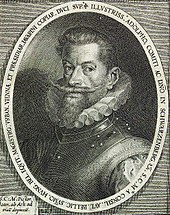
- 1566–1596 Christoph (II.)
- 1596–1646 Georg Ludwig; after his death Hohenlandsberg fell back to Schwarzenberg by will.
Count of Schwarzenberg
- 1599–1600 Adolf , imperial military leader
- 1600–1641 Adam , influential advisor to Elector Georg Wilhelm von Brandenburg
- 1641–1670 Johann Adolf ; Hohenlandsberg fell to him again in 1646
Prince of Schwarzenberg
- Johann Adolf I zu Schwarzenberg (1615–1683), 1670 Prince of Schwarzenberg; ⚭ Countess Maria Justina von Starhemberg , daughter of Ludwig
- Ferdinand Wilhelm Eusebius (1652–1703), his son, 2nd Prince of Schwarzenberg , count in 1688 and count of Sulz in 1698 ; ⚭ Countess Maria Anna von Sulz - his sister inherits her husband, Prince Johann Christian von Eggenberg zu Krumau ; with her death in 1719, Krumau fell to Schwarzenberg
- Adam Franz Karl Eusebius (1680–1732), his son, 3rd Prince of Schwarzenberg , Austrian Obersthofmarschall; ⚭ Princess Eleonora von Lobkowitz , daughter of Ferdinand August (3rd Prince of Lobkowitz )
- Joseph I (1722–1782), his son, 4th Prince of Schwarzenberg ; ⚭ Princess Maria Theresia von und zu Liechtenstein, daughter of Prince Joseph I - receives the Prince's diploma extended to the effect that all legitimate male and female descendants are allowed to use the title “Prince” or “Princess” and thus becomes a prince and state prince raised by a Bohemian prince
- Johann I. Nepomuk (1742–1789), his son, 5th Prince of Schwarzenberg ; ⚭ Countess Marie Eleonore zu Oettingen-Wallerstein, daughter of Philipp Karl, Count von Oettingen-Wallerstein
First majorat
- Joseph II (1769–1833), son of Johann I, 6th Prince of Schwarzenberg , Duke of Krumau, landowner; ⚭ Princess Pauline Caroline d'Arenberg, daughter of Ludwig Engelbert , Duc d'Arenberg, Duc d'Aerschot
- Johann Adolf II. (1799 1888), his son, 7th Prince of Schwarzenberg , Duke of Krumau, landowner (brother of the Austrian Prime Minister Felix zu Schwarzenberg and the Prague Archbishop Friedrich zu Schwarzenberg ); ⚭ Princess Eleonore von und zu Liechtenstein (daughter of Moritz Joseph Johann Baptist)
- Adolf Joseph (1832–1914), his son, 8th Prince of Schwarzenberg , Duke of Krumau, major, landowner and politician; ⚭ Princess Ida von und zu Liechtenstein (daughter of Prince Alois II. )
- Johann II. (1860–1938), his son, 9th Prince of Schwarzenberg , Duke of Krumau, landowner, member of parliament and major; ⚭ Countess Therese von und zu Trauttmansdorff -Weinsberg (daughter of Prince Karl Johann Nepomuk Ferdinand)
- Adolph (August 18, 1890-27 February 1950), his son; ⚭ Princess Hilda of Luxembourg and Nassau, daughter of Grand Duke Wilhelm ; since the marriage remained childless, in 1940 he adopted the younger brother of his cousin Joseph III, Heinrich Herzog von Krumau
- Joseph III (1900–1979), nephew of Johann II .; after his death the two lines merged to Karel Schwarzenberg
Second majorat

- Karl I. Philipp zu Schwarzenberg (1771–1820), son of Prince Johann I, 1804 Prince zu Schwarzenberg, Landgrave of Sulz and Klettgau , field marshal and diplomat ⚭ Countess Maria Anna von Hohenfeld
- Karl II. (1802-1858), his son, Prince zu Schwarzenberg, Feldzeugmeister and administrative officer; ⚭ Countess Josefina Marie Wratislavova z Mitrowicz
- Charles III (1824–1904), his son, Prince zu Schwarzenberg, landowner and member of parliament ⚭ Princess Wilhelmine Marie zu Oettingen-Oettingen, daughter of Friedrich Kraft, Prince of Oettingen-Oettingen and Oettingen-Wallerstein
- Charles IV (1859–1913), his son, Prince zu Schwarzenberg, landowner and politician ⚭ I. Countess Marie Terezie Kinsky von Wchinitz and Tettau; ⚭ II. Countess Ida Hoyos, Baroness von Sprinzenstein
- Charles V (1886 1914), his son, Prince zu Schwarzenberg ⚭ Countess Eleonore von Clam and Gallas
- Charles VI (1911 1986), his son; ⚭ Antonie Leontine Princess zu Fürstenberg, daughter of Karl Emil
- Charles VII (* 1937), his son, adopted in 1960 by Heinrich Herzog von Krumau (brother Joseph III); after the death of Joseph III. Union of the two lines; Foreign Minister of the Czech Republic ⚭ Terezia zu Hardegg on Glatz and in the Machlande
- Johannes Nepomucenus (* 1967)
Other personalities
- Ernst Fürst zu Schwarzenberg (first majorate) (1773–1821), bishop and composer
- Friedrich Johann Nepomuk Prince zu Schwarzenberg (1774–1795), Austrian Chevauxlegers officer, fatally wounded near Mannheim ; with memorial in Weinheim , Baden-Württemberg (death room and tomb).
- Friedrich Karl Fürst zu Schwarzenberg (Second Majorat) (1800–1870), son of Karl I, major general and war writer
- Felix Fürst zu Schwarzenberg (first majorate) (1800–1852), cousin of Friedrichs, field marshal lieutenant, diplomat and prime minister
- Edmund Fürst zu Schwarzenberg (1803–1873), last Austrian field marshal appointed in the 19th century
- Prince Friedrich zu Schwarzenberg (first majorate) (1809–1885), brother of Felix, cardinal and archbishop of Salzburg and Prague
- Johann von Nepomuk Erkinger Schwarzenberg (1903–1978), Austrian ambassador
Prince Adam von Schwarzenberg (1680–1732), Obersthofmarschall, Oberststallmeister
Prince Joseph I. von Schwarzenberg (1722–1782)
Prince Karl Philipp zu Schwarzenberg (1771–1820), field marshal
Prince Felix zu Schwarzenberg (1800-1852), Prime Minister
Cardinal Friedrich zu Schwarzenberg (1809–1885), Archbishop of Salzburg and Prague
Frisian Line ( Barone thoe Schwartzenberg en Hohenlansberg )
- see also the Dutch article Thoe Schwartzenberg en Hohenlansberg
The Frisian line of barons thoe Schwartzenberg en Hohenlansberg , which is still flourishing in the Netherlands today , was founded by Johann Onuphrius von Schwarzenberg and Hohenlandsberg (1513–1584), who was a son of Wolfgang († 1543) and grandson of Michael von Schwarzenberg zu Hörblach (first documented in 1473 ; † 1489) was, a younger son of Michael II von Seinsheim, Freiherr zu Schwarzenberg (1437–1469) from his second marriage - see above in the section Lords of Seinsheim and Barons of Schwarzenberg .
Johann Onuphrius married Maria von Grombach († 564), whose father had come to the Netherlands with Emperor Charles V and there had married Lucia Martena, the heiress of Groot Terhorne Castle ( Menameradiel community ). The moated castle remained in the family until it was demolished in 1879 because of dilapidation; the family moved into villas in the area.
The descendants from the second marriage of Michael II von Seinsheim, Freiherr zu Schwarzenberg (1437–1469) with Ursula Grüner were never recognized by the princely line that came from the first marriage, as there were doubts about the legitimacy of the descendants because Ursula Grüner "In addition to the marriage with Michael, I had children who were only legitimized after the hand", as was established in a 1672 process. The "West Frisian Schwarzenbergers" nonetheless carried the title awarded to Michael II as imperial barons to Schwartzenberg and Hohenlandsberg , since the second half of the 18th century thoe Schwartzenberg en Hohenlansberg in Dutch spelling .
With a resolution of August 28, 1814, the line with the title Barone thoe Schwartzenberg en Hohenlansberg was accepted by Wilhelm I into the Dutch nobility. Some descendants went to Prussia at the end of the 19th century and were accepted into the local nobility as barons.
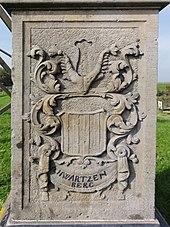
- Stem row
- Michael von Schwarzenberg zu Hürblach († 1489), younger son of Michael II. Von Seinsheim, Freiherr zu Schwarzenberg and Hohenlandsberg (1437–1469)
- Wolfgang († 1543)
- Johann Onuphrius (1513–1584) ⚭ Maria von Grombach , heiress of Terhorne
- Georg Wolfgang (1549-1633)
- Johannes Onuphrius († 1627)
- Georg Friedrich (1607–1670)
- Isabella Susanna (1640–1723), ⚭ 1685 Count Gustav Carlsson von Börring (1649–1708), natural son of King Charles X Gustav of Sweden
- Georg Wilco (1637–1674)
- Wilco George (1664-1704)
- Georg Wolfgang (1691–1738)
- Georg Frederik (1733–1783), Frisian politician and writer, descendants: see below
- Michael Onuphrius (1695–1758), Mayor of Dantumadiel , Deputy of Friesland
- Wilco (1738–1788), mayor, deputy of Friesland
- Georg Wolfgang (1691–1738)
- Wilco George (1664-1704)
- Georg Friedrich (1607–1670)
- Johannes Onuphrius († 1627)
- Georg Wolfgang (1549-1633)
- Johann Onuphrius (1513–1584) ⚭ Maria von Grombach , heiress of Terhorne
- Wolfgang († 1543)
- Descendants of Georg Frederik (1733–1783):
- Georg Wolfgang (1766–1808)
- Georg Frederik (1791–1868), had five sons
- Ulbo
- Georg Frederik (* 1864)
- Georg Wolfgang Carel (* 1899)
- Georg Frederik (* 1934)
- Georg Wolfgang (* 1963)
- Watze Julius (* 1936)
- Georg Willem (* 1970)
- Anthony Johan (* 1972)
- Georg Frederik (* 1934)
- Wilco Holdinga Tjalling Camstra (* 1904)
- Georg Frederik (* 1947)
- Willem Holdinga (* 1950)
- Gemme Onuphrius (* 1953)
- Georg Wolfgang Carel (* 1899)
- Georg Frederik (* 1864)
- Ernest Louis (1827-1888)
- Remmo (1869-1929)
- Wilco Remmo (1917–1988)
- Wilco Remmo (* 1948)
- Ubbo Wilco (born 1976)
- Ijsbrand Radinck (* 1979)
- Wilco Remmo (* 1948)
- Wilco Remmo (1917–1988)
- Remmo (1869-1929)
- Ulbo
- Georg Frederik (1791–1868), had five sons
- Jan Sicco (1693-1757)
- Wilco Holdinga Tjalling (1738–1800)
- Johan Sicco Tjalling Camstra, Baron thoe Schwarzenberg en Hohenlandsberg (1769–1829), Dutch politician, member of the Provincial States of Friesland and the Council for the West Indian Colonies
- Wilco Holdinga Tjalling Camstra (* 1805), member of the provincial states of Friesland
- Henri Lodewijk (1841–1922), manor owner in Silesia
- Wilco Holdinga (1881–1945), German lieutenant captain
- Wolfgang (* 1919)
- Bertha (1891–1993), Dutch sculptor, wife of the painter Klaas Koster (1885–1969)
- Wilco Holdinga (1881–1945), German lieutenant captain
- Georg Friedrich Alexander (1842–1918), Prussian Rittmeister, accepted into the Prussian nobility as a baron
- Wolfgang (1895-1915)
- Henri Lodewijk (1841–1922), manor owner in Silesia
- Wilco Holdinga Tjalling Camstra (* 1805), member of the provincial states of Friesland
- Johan Sicco Tjalling Camstra, Baron thoe Schwarzenberg en Hohenlandsberg (1769–1829), Dutch politician, member of the Provincial States of Friesland and the Council for the West Indian Colonies
- Wilco Holdinga Tjalling (1738–1800)
Curiosities

According to a regional popular superstition, Eleonore von Schwarzenberg (1682–1741), née Princess Lobkowitz , was up to mischief as a vampire . A documentary film entitled Die Vampirprinzessin was produced for Arte and ORF in 2007 about the life of Prince Adam Franz's wife .
literature
- Heinrich Zoepfl: Memorandum concerning the high nobility and the equality of the Count's House of Seinsheim , Heidelberg 1867.
- Constantin von Wurzbach : Schwarzenberg, the princely house, genealogy . In: Biographisches Lexikon des Kaiserthums Oesterreich . 33. Part. Kaiserlich-Königliche Hof- und Staatsdruckerei, Vienna 1877, pp. 2–10 ( digitized version ).
- Constantin von Wurzbach : Schwarzenberg, archive . In: Biographisches Lexikon des Kaiserthums Oesterreich . 33. Part. Imperial and Royal Court and State Printing Office, Vienna 1877, p. 34 ( digitized version ).
- Constantin von Wurzbach : Schwarzenberg, crypt of the house . In: Biographisches Lexikon des Kaiserthums Oesterreich . 33. Part. Imperial-Royal Court and State Printing Office, Vienna 1877, p. 34 f. ( Digitized version ).
- Constantin von Wurzbach : Schwarzenberg, coat of arms . In: Biographisches Lexikon des Kaiserthums Oesterreich . 33. Part. Imperial and Royal Court and State Printing Office, Vienna 1877, p. 35 ( digitized version ).
- Anton Moerath: Contributions to the history of the Rhenish line of the Princely House of Schwarzenberg. Voss, Düsseldorf 1877 ( digitized version )
- Anton Tannich: The coins and medals of the princes of Schwarzenberg , In: Schwarzenbergisches Jahrbuch 1938, pp. 51–150.
- Prince Karl zu Schwarzenberg: History of the Imperial House of Schwarzenberg . Degener, Neustadt an der Aisch 1963.
- Wolfgang Wüst: The Seinsheim-Schwarzenberg files: a Franconian aristocratic rule before the Reich Chamber of Commerce, In: Yearbook for Franconian State Research 62 (2002) pp. 203-230.
- Wolfgang Wüst: The Schwarzenberg in Franconia and Bohemia. Freiherren - Grafen - Fürsten , In: Yearbook for Franconian State Research 74 (2014) pp. 115–130, ISBN 978-3-940049-20-9 .
- Zdeněk Bezecný: Schwarzenberg. In: New German Biography (NDB). Volume 24, Duncker & Humblot, Berlin 2010, ISBN 978-3-428-11205-0 , pp. 18-20 ( digitized version ).
- Kurt Andermann : Seinsheim. In: New German Biography (NDB). Volume 24, Duncker & Humblot, Berlin 2010, ISBN 978-3-428-11205-0 , pp. 194-196 ( digitized version ).
- Jesko Graf zu Dohna, Robert Schuh: In the footsteps of the princes of Schwarzenberg . Scheinfeld 2006.
- Genealogisches Handbuch des Adels , Adelslexikon Volume XIII, Volume 128 of the complete series, pp. 201-206, C. A. Starke Verlag, Limburg (Lahn) 2002, ISSN 0435-2408 .
Web links
- Genealogy at genealogy.euweb.cz , starting with Sifridus de Sovvensheim, † 1209
- SCHWARZENBERG (English), starting with Johann Adolf 1670
- Schwarzenberg, high nobility - AEIOU
- The history of the Schwarzenbergs in Marktbreit
- Coat of arms of the von Schwarzenberg family
Individual evidence
- ^ Genealogisches Handbuch des Adels, Adelslexikon Volume XIII, p. 202, C. A. Starke Verlag, 2002.
- ↑ Press release of the General Directorate of the Bavarian State Archives: The Scheinfeld Castle Archive of the Princes of Schwarzenberg is returning to Middle Franconia from the Czech Republic after more than 60 years. ( Memento from March 10, 2012 in the Internet Archive )
- ↑ due to the same name of an earlier born from the older Bavarian line
- ↑ see title page of his work From the traveling book of a farewell Lanzknechte
- ^ Constant Wurzbach von Tannenberg: Schwarzenberg, the princely house, genealogy .
- ↑ Nederland's Adelsboek 92 (2006-2007), pp. 563-599.
- ↑ GHdA , Adelslexikon Volume XIII, Complete Series Volume 128, Limburg an der Lahn 2002, pp. 190 f.
- ↑ ELEONORE VON SCHWARZENBERG - THE VAMPIRE PRINCESS ON THE CANVAS. German, Radie Prague International, April 29, 2007.
- ↑ The Vampire Princess. arte.tv, July 24, 2010, archived from the original on January 17, 2008 ; Retrieved December 21, 2012 .
